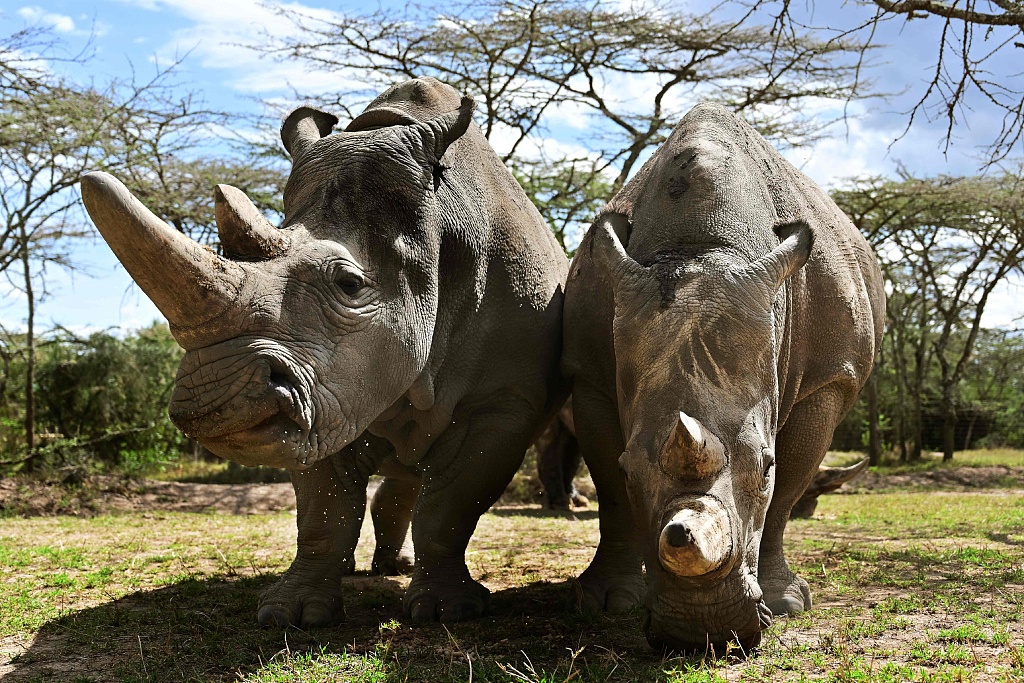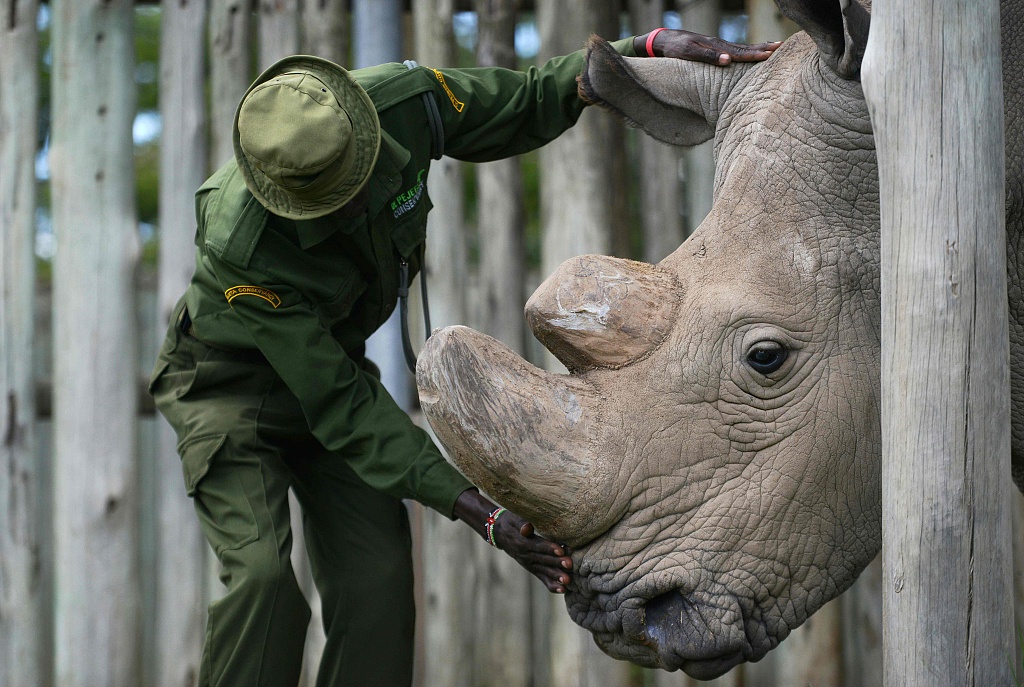Rhinos are the second largest land mammal on Earth. Their leathery skin, enormous bodies and stout horns often remind dinosaur lovers of Triceratops in prehistoric times.
There are now five rhino species living in the world: the black rhino and the white rhino, which roam in Africa, and the Sumatran, Javan and Indian rhinos, which live in Asia.
Among them, the northern white rhino, a subspecies of the white rhino, is the most endangered, with only two females left in the world, while the southern white rhino is the only one of the five rhino species that is not endangered. What are the stories behind these two subspecies that lead them to different paths?

The world's last female pair of northern white rhinos, Najin (L) with her daughter Fatu in their enclosure at Ol Pejeta Conservancy, Kenya, May 28, 2019. /CFP
The world's last female pair of northern white rhinos, Najin (L) with her daughter Fatu in their enclosure at Ol Pejeta Conservancy, Kenya, May 28, 2019. /CFP
Northern VS Southern
Northern white rhinos once roamed northwestern Uganda, southern Chad, southwestern Sudan, the eastern part of Central African Republic and northeastern Democratic Republic of Congo (DRC). In the 1960s, there were still around 2,360 northern white rhinos. However, poaching and various other reasons caused their sharp population decline.
In 2009, the last four breeding individuals (two males and two females) were sent from the zoo to Kenya's Ol Pejeta Conservancy in a final attempt to save the subspecies from extinction. Sadly, in 2018, the last male northern white rhino, Sudan, died. The last two female northern white rhinos are its daughter Najin and granddaughter Fatu. They are both old and incapable of reproduction even if they had a mate.
In the late 19th century, southern white rhinos were also on the brink of extinction. However, over a century of persistent conservation has brought them from fewer than 100 individuals to 15,940 in 2021. Will northern white rhinos have the same luck as their southern relatives?

A caregiver calms Sudan, the last known male of the northern white rhino subspecies, at the Ol Pejeta conservancy, Kenya, December 5, 2016. /CFP
A caregiver calms Sudan, the last known male of the northern white rhino subspecies, at the Ol Pejeta conservancy, Kenya, December 5, 2016. /CFP
Two approaches
Hopefully, a novel and innovative approach to rescue northern white rhinos has been proposed by BioRescue, a scientific consortium led by Leibniz Institute for Zoo and Wildlife Research (Leibniz-IZW) in Germany. The strategy combines assisted reproductive technology and stem-cell associated technique.
Oocytes, or egg cells, are harvested from Najin and Fatu, and they will be fertilized by sperm collected from deceased northern white rhino males (e.g. Sudan). Embryos of northern white rhinos are supposed to be produced in the lab and later transferred to their surrogate mothers – southern white rhinos, who are genetically close to northern white rhinos and have the same gestation period of 16 to 18 months. Therefore, they are expected to give birth to a new generation of northern white rhinos.
Besides, researchers have another option called stem-cell associated technique. This process begins with collecting cells from skin tissue of northern white rhinos, and follows by converting skin cells to induced pluripotent stem cells (iPSCs) using genetic reprogramming. These stem cells are able to be transformed into any other cells. Egg cells are expected to be created to produce artificial embryos with preserved sperm, which will be implanted to southern white rhino surrogates.

A female southern white rhino with her 2-month-old baby in the Ziwa Rhino Sanctuary in Uganda. /CFP
A female southern white rhino with her 2-month-old baby in the Ziwa Rhino Sanctuary in Uganda. /CFP
Achievements so far
Until February 2022, using the first method, 14 northern white rhino embryos have been successfully created by utilizing Fatu's eggs and the preserved sperm and they are stored in liquid nitrogen for future embryo transfers. However, researchers decided not to obtain eggs from Najin in 2021 due to her age and the condition of her remaining eggs.
Considering that northern white rhino embryos are so rare, there is an urgent need to use the second approach, the stem-cell associated technique, to produce embryos as researchers could ideally create as many eggs or sperms as they want in lab.
Currently, scientists have succeeded in producing iPSCs from skin cells of northern white rhinos, and they are working on the next stage – differentiating iPSCs to egg cells. To ensure the viable embryos are used effectively, BioRescue will first test the implantation process using southern white rhino embryos to prove that a healthy calf can be born from a lab-created embryo.
In the foreseeable future, northern white rhino embryos are anticipated to be transferred to the wombs of southern white rhinos. Could this subspecies be brought back from extinction? The future is uncertain and it is a race against time.

